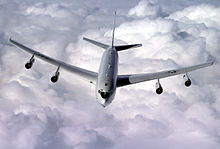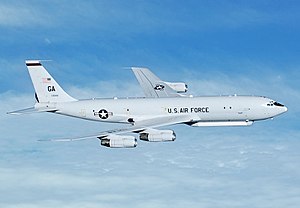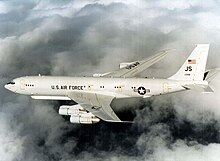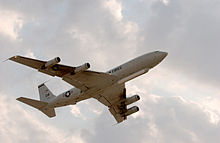Northrop Grumman E-8
The Northrop Grumman E-8 Joint STARS is an aircraft of the US Air Force (USAF) , which is used for battlefield surveillance. It serves as the airborne command and control center for all units and is the counterpart of the E-3 Sentry AWACS used for ground targets .
assignment
The E-8 is based on the Boeing 707-300 built by the US aircraft manufacturer Boeing and is equipped with various electronic and radar systems, externally recognizable by a 12-meter-long AN / APY-7 side-view radar on the underside of the front fuselage. In the main deck of the aircraft there are 18 workstations for the operators who operate and monitor the radar systems, electronics and communications .
The AN / APY-7 Synthetic Aperture Radar of the E-8 can detect troop and vehicle movements over 250 km away regardless of the weather and time of day. The information collected is evaluated, sent via Link 16 and then used without delay to instruct and guide your own army units on the ground. Also, combat aircraft , attack helicopters and artillery - and missile units provide data to targets. It provides a comprehensive picture of the battlefield and is a very important component of the Network Centric Warfare sensor grid .
Development and use
JSTARS
The USAF and the US Army each developed their own airborne reconnaissance system for enemy movements in the 1970s : The Air Force's pave mover program comprised radar surveillance and detection of moving targets including a weapons control system and had successfully completed the test phase, while the Army's helicopter-based enemy detection system SOTAS had problems with tests prepared. In 1982 the US Department of Defense decided to start the development as a joint program under the name JSTARS ( J oint S urveillance T arget A ttack R adar S ystem; in German: Joint surveillance, target and attack radar system) , later Joint STARS , and looked for a suitable carrier for the system. From 2012 onwards, these aircraft are to be modernized by Northrop , including converting the software for the operating consoles to Linux .
E-8
In May 1984 the decision was made to use the (used) Boeing 707 as the platform (after experimenting with the Tacit Blue stealth aircraft ), in September 1985 Grumman received the order for the entire system, while the long-range side-view radar was to be supplied by Norden Systems . Initially, the construction of two machines as test vehicles and ten for use by the Air Force was planned. The first E-8A - a B707-300C originally delivered to Qantas Airways in 1968 - flew in April 1988. While still in the test phase, two E-8s flew around 50 missions in 1991 as part of Operation Desert Storm in the Second Gulf War over Iraq and Kuwait and were convincing with the investigation of Iraqi troop movements.
In 2008 plans were announced to equip the JSTARS fleet with other engines, and two options were discussed, firstly the replacement by JT8D-219 from Pratt & Whitney, and secondly with CFM56 from General Electric . The savings for the CFM56 turbofans were calculated to be approx. 27%, the savings for the JT8 turbo jets are smaller because they are almost as old as the TF33s already in use, but the approval process would be clear due to the same structure of the JT8 and TF33 cheaper. The decision was made in 2009 in favor of the JT8 solution, but no funds were made available for a retrofit until September 2016, as a successor should be ready by 2022.
The machines are being overhauled by Northrop in Lake Charles , Louisiana . After repair and modernization work, there were several technical problems with machines, which the United States Air Force attributed to incorrectly performed work by Northrop. For example, the ground radar of a machine was damaged because the valves provided for it could not dissipate the moisture generated in the radome during flight; the damage is estimated to amount to more than $ 2 million. As a result of the incident, four other JSTARS were banned from flying for about a week, but no further damage was found.
future
In 2015, the US government placed an order for the development of a JSTARS successor to Northrop, Boeing and Lockheed Martin, Northrop then offered to modernize the existing E-8 fleet as an E-8D and that the further development of the platform would be 85% be completed; other ideas envisage developing an aircraft type similar to the British Sentinel R1 fleet based on a business jet . At the beginning of 2018, the US Air Force announced that it would request the US Congress with the budget for 2019 to discontinue the successor program and to retire the E-8 fleet in 2025. Secretary of the Air Force Heather Wilson argued, among other things, that it was not assumed that a corresponding, manned aircraft could be used in an armed conflict without an acceptable risk. Instead, a solution based on the Northrop APY-7 radar is to be procured.
“It's entirely possible that the Congress could say, 'No, we want you to build JSTARS', they need to understand that we don't believe JSTARS will survive and be able to be deployed and used in a highly contested environment - China or Russia - post-2025. "
"In the not unlikely event that Congress says, 'No, we would like the JSTARS [successor] platform to be developed,' members need to understand that we do not assume that JSTARS is in a dispute with China or Russia survived and can be relocated and deployed accordingly after 2025. "
units
All 17 machines belong to the 461st Air Control Wing , which reports to Air Combat Command and is based at Robins Air Force Base , Georgia , about 150 kilometers southeast of Atlanta .
Versions
- E-8A : Two machines for testing the equipment from 1988–2000
- E-8B : Version planned since April 1988, but canceled in November 1989 with the new Boeing 707; only one prototype (YE-8B) was built.
- E-8C : Actual production series from converted B707; the last of 17 machines was delivered on March 23, 2005.
Incidents
- On September 24, 2005, a US Air Force E-8C was badly damaged by Hurricane Rita at Lake Charles Municipal Airport in Louisiana.
- On March 13, 2009, an E-8 was so badly damaged during an air refueling that fuel flowed from several openings in the wings; the mission was canceled and the crew was able to land safely in Qatar. During the subsequent investigation, it was found that a company commissioned with repairs to the tank had sealed several pressure compensation valves during the work and then forgot to remove them, so that an overpressure had developed that severely damaged the structure of the wing and the outer skin . The cost of the repair was estimated by the USAF at over $ 25 million.
Technical specifications

| Parameter | E-8C data |
|---|---|
| crew | 4 cockpit crew, 18 operators |
| length | 46.61 m |
| span | 44.42 m |
| height | 12.95 m |
| Empty mass | 77,564 kg |
| Max. Takeoff mass | 152,407 kg |
| Fuel capacity | 70,306 kg |
| Engines | 4 × Pratt & Whitney TF33 -102C turbofans with 85.4 kN thrust each |
| Marching speed | 945 km / h |
| Top speed | 973 km / h |
| Service ceiling | 12,802 m |
| Duration of use | approx. 9 hours |
| Range | 9270 km |
See also
Web links
Individual evidence
- ^ Zach Rosenberg: Northrop progresses E-8 Joint STARS modification. Flightglobal.com, September 20, 2012, accessed September 20, 2012 .
- ↑ Re-engining the E-8 JSTARS. In: Defense Industry Daily. December 18, 2011, accessed September 24, 2016 .
- ^ JSTARS Replacement: Competition Opened Wide. In: Defense Industry Daily. March 28, 2016, accessed September 24, 2016 .
- ↑ Leigh Giangreco: Four JSTARS grounded for inspection. In: Flightglobal.com. September 23, 2016, accessed September 24, 2016 .
- ↑ Leigh Giangreco: JSTARS flying again following radar mishap. In: Flightglobal.com. September 26, 2016, accessed September 28, 2016 .
- ↑ James Drew: Northrop calls for quicker JSTARS schedule as “E-8D” takes shape. In: Flightglobal.com. September 4, 2015, accessed on September 4, 2015 (English): "Northrop Grumman says it shouldn't take 16 years for the US Air Force's to recapitalize the Boeing 707-based E-8C Joint Surveillance Target Attack Radar System, and it doesn't need an 11-month "risk-reduction" phase to get started. "
- ↑ a b STEPHEN TRIMBLE: USAF has no plans for all-weather, wide area surveillance after JSTARS. In: FLIGHTGLOBAL.COM. February 26, 2018, accessed February 26, 2018 .
- ↑ Welcome to the 461st Air Control Wing. In: United States Air Force. Retrieved September 24, 2016 .
- ↑ Aircraft accident data and report in the Aviation Safety Network (English)
- ^ John Reed, A Basic Mistake That Trashed a JSTARS. In: Defenstech. January 27, 2012, accessed September 24, 2016 .



